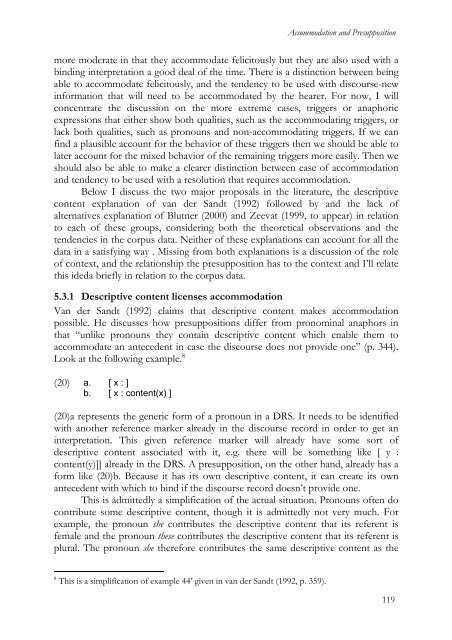Presuppositions in Spoken Discourse
Presuppositions in Spoken Discourse
Presuppositions in Spoken Discourse
You also want an ePaper? Increase the reach of your titles
YUMPU automatically turns print PDFs into web optimized ePapers that Google loves.
Accommodation and Presupposition<br />
more moderate <strong>in</strong> that they accommodate felicitously but they are also used with a<br />
b<strong>in</strong>d<strong>in</strong>g <strong>in</strong>terpretation a good deal of the time. There is a dist<strong>in</strong>ction between be<strong>in</strong>g<br />
able to accommodate felicitously, and the tendency to be used with discourse-new<br />
<strong>in</strong>formation that will need to be accommodated by the hearer. For now, I will<br />
concentrate the discussion on the more extreme cases, triggers or anaphoric<br />
expressions that either show both qualities, such as the accommodat<strong>in</strong>g triggers, or<br />
lack both qualities, such as pronouns and non-accommodat<strong>in</strong>g triggers. If we can<br />
f<strong>in</strong>d a plausible account for the behavior of these triggers then we should be able to<br />
later account for the mixed behavior of the rema<strong>in</strong><strong>in</strong>g triggers more easily. Then we<br />
should also be able to make a clearer dist<strong>in</strong>ction between ease of accommodation<br />
and tendency to be used with a resolution that requires accommodation.<br />
Below I discuss the two major proposals <strong>in</strong> the literature, the descriptive<br />
content explanation of van der Sandt (1992) followed by and the lack of<br />
alternatives explanation of Blutner (2000) and Zeevat (1999, to appear) <strong>in</strong> relation<br />
to each of these groups, consider<strong>in</strong>g both the theoretical observations and the<br />
tendencies <strong>in</strong> the corpus data. Neither of these explanations can account for all the<br />
data <strong>in</strong> a satisfy<strong>in</strong>g way . Miss<strong>in</strong>g from both explanations is a discussion of the role<br />
of context, and the relationship the presupposition has to the context and I’ll relate<br />
this ideda briefly <strong>in</strong> relation to the corpus data.<br />
5.3.1 Descriptive content licenses accommodation<br />
Van der Sandt (1992) claims that descriptive content makes accommodation<br />
possible. He discusses how presuppositions differ from pronom<strong>in</strong>al anaphors <strong>in</strong><br />
that “unlike pronouns they conta<strong>in</strong> descriptive content which enable them to<br />
accommodate an antecedent <strong>in</strong> case the discourse does not provide one” (p. 344).<br />
Look at the follow<strong>in</strong>g example. 8<br />
(20) a. [ x : ]<br />
b. [ x : content(x) ]<br />
(20)a represents the generic form of a pronoun <strong>in</strong> a DRS. It needs to be identified<br />
with another reference marker already <strong>in</strong> the discourse record <strong>in</strong> order to get an<br />
<strong>in</strong>terpretation. This given reference marker will already have some sort of<br />
descriptive content associated with it, e.g. there will be someth<strong>in</strong>g like [ y :<br />
content(y)]] already <strong>in</strong> the DRS. A presupposition, on the other hand, already has a<br />
form like (20)b. Because it has its own descriptive content, it can create its own<br />
antecedent with which to b<strong>in</strong>d if the discourse record doesn’t provide one.<br />
This is admittedly a simplification of the actual situation. Pronouns often do<br />
contribute some descriptive content, though it is admittedly not very much. For<br />
example, the pronoun she contributes the descriptive content that its referent is<br />
female and the pronoun these contributes the descriptive content that its referent is<br />
plural. The pronoun she therefore contributes the same descriptive content as the<br />
8 This is a simplification of example 44’ given <strong>in</strong> van der Sandt (1992, p. 359).<br />
119











